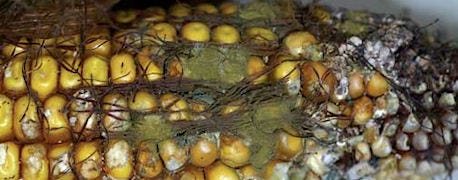September 14, 2012

Drought conditions this season have many interested in the prevalence of aflatoxin in the U.S. grain supply, but the U.S. Grains Council says it is closely monitoring aflatoxin levels in the United States so concerns of global customers may be addressed.
Aflatoxin, which may be produced by the fungus Aspergillus under certain conditions, can cause sickness or death in animals at elevated levels. For most uses, corn cannot test above 20 ppb for aflatoxin, according to FDA guidelines, which are based on maintaining performance and avoiding disease related to aflatoxin.

Yellow-green powdery growth of Aspergillus flavus on a corn rootworm-damaged ear. Aspergillus can lead to aflatoxin. (Photo courtesy Iowa State University)
All corn export shipments from the United States are tested for aflatoxin, and buyers can specify additional testing should they choose.
Some aflatoxin levels have been observed in several U.S. Corn Belt states, with almost all below the 20 ppb limit. For example, one private grain inspection service in Nebraska said most of the tests it has completed were zero or only one ppb. Those lots of corn with elevated aflatoxin levels will be diverted into feed for local beef cattle that can consume that grain without harmful health effects.
"So far this harvest season, aflatoxin does not appear to be a significant problem," said Kansas State University's Jay O'Neil. "However, we will know more once more of the crop has been harvested, and certainly we will keep an eye on it."
About 10% of the crop has been harvested as of Sept. 2.
Alison Robertson, plant pathologist at Iowa State University, said the problem in Iowa is not widespread, but the conditions are right.
"Fields across the state are at risk for aflatoxin considering the hot, dry conditions we had during pollination and are having now as much of the crop reaches black layer," Robertson cautioned.
Corn-based ethanol plants, which produce distiller's dried grains with solubles generally have a lower aflatoxin threshold – even zero – because aflatoxin can be concentrated in the DDGS. U.S. DDGS importers who are concerned can require aflatoxin testing and set limits in their purchase contracts.
Local grain elevators screen all incoming loads of corn for the aflatoxin-producing fungus. Grain elevators can refuse corn that is over 20 ppb aflatoxin unless they can segregate it from non-contaminated corn and they have a known, approved local use for it, USGC said.
The Council's annual U.S. Corn Harvest Quality Report, set to be released at the end of November, will be a key tool in releasing information from this year's harvest.
You May Also Like




